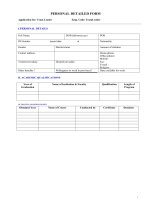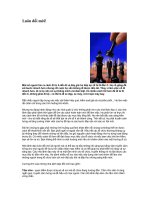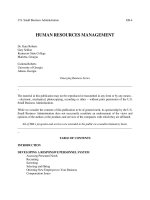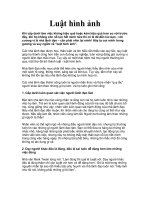Tài liệu "WHAT COUNTS" FACTORS ppt
Bạn đang xem bản rút gọn của tài liệu. Xem và tải ngay bản đầy đủ của tài liệu tại đây (249.21 KB, 23 trang )
PGV Product Supply
Title: PERFORMANCE EVALUATION CRITERIA
Purpose: To provide criteria for employee performance
evaluation
Document No.
S-02-07-03-05.0
Process Owner: Rewards/
Recognition System Owner
Prepared by: Rewards/ Recognition
System Owner
Copy No. Process Customer: All employees
Concurred by : HRIT
Issue Date:
20/12/1997
Next Review:
20/1/1998
Issue No. 1 Approved by: Plant Systems Owner
"WHAT COUNTS" FACTORS
FACTORS OF EFFECTIVE PERFORMANCE
The primary outcome expected from everyone has two key components.
BUILDS THE BUSINESS
Consistently delivers high-quality results, both short-and long-term.
BUILDS ORGANIZATION CAPACITY
- Develops own capabilities.
- Supports the development and full utili8zation of others' capabilities and the recruiting, training and retention
efforts of the organization.
- Improves business processes - how the organization accomplishes its objectives.
Following are the Key factors contributing to these outcomes. The extent to which each factor influences
outcomes depends on the person's job responsibilities. Use of these Factors, therefore, should be tailored to the
specific responsibilities of the individual.
PRIORITY-SETTING
WORKING EFFECTIVELY WITH OTHERS
- Thinks in terms of creating quality and value for
consumers.
- Demonstrates integrity and high personal standards.
- Defines who his/her customers are : seeks to
understand their needs; sets priorities with those in
mind.
- Respects and works effectively with diverse people;
enables all to contribute their best work.
- Recognizes the most important issues; makes
effective plans; gets resources in place to achieve
key objectives.
- Build and maintains productive working
relationships, even in difficult situations.
- Works with the end result in mind, despite
obstacles.
- Works across organizations to develop the best
approaches and get the best results.
THINKING/PROBLEM - SOLVING
COMMUNICATION
- Sorts through complex data: gathers other relevant
viewpoints; identifies important issues; thinks
through alternatives.
-
Seeks first to understand, then to be understood.
-
Integrates intuition and data from a variety of
sources; makes well-reasoned conclusions and
develops a solid plan of action.
- Organizes and expresses thoughts clearly and
concisely, both in speaking and writing, so that
others understand.
- Learn from successes and mistakes to solve
problems better.
- Expresses ideas in ways that build commitment to
them, even when unfamiliar or unpopular, involves
and fully informs others in a timely way.
- Recognizes developing problems and handles
them well
- Recognizes cultural differences and communicates
in ways that work.
INITIATIVE AND FOLLOW-THROUGH
CREATIVITY AND INNOVATION
- Gets going on important priorities; overcomes
obstacles and takes appropriate risks; keeps
moving toward objectives.
- Takes a broad view; finds meaningful connections;
uses both logic and intuition to define problems and
solutions.
- Handles multiple priorities well. - Goes beyond the accepted ideas; finds new
improvement opportunities; generates ways to get
better results.
- Sets specific, stretching objectives, and meets or
exceeds them.
- Searches out and reapplies proven ideas and
methods to new situations.
- Finds improved ways of getting results. - Translates new ideas into workable solutions;
encourages others to do the same.
LEADERSHIP
TECHNICAL MASTERY
- Recognizes opportunities; forms a vision of what
can be achieved, then challenges self and others to
get the desires result.
- Achieves technical mastery and develops it in
others.
- Champions ideas and people to get breakthrough
results.
- Converts technical skill into practical applications to
better meet consumer needs.
- Users a variety of resources effectively - Integrates linkages with the business process of
suppliers and customers.
FACTORS OF EFFECTIVE PERFORMANCE - KEY COMPONENTS
1. BUILD THE BUSINESS
ELEMENTS
EXCEPTIONAL
STRONG
FUNDAMENTAL
IMPROVEMENT AREA
•
Consistently delivers high-
quality results, both short
and long-term
- Defines measures &
targets for business
results in area
- Defines and analyzes
areas where
improvement can be
made to beat
competitors
- Understands the major
competitors of products
- Seldom meets targets or
completes plans (under 75
of goals not met)
- Leads others in
achieving competitive
advantage
- Plans & executes steps
to improve area results
- Executes plans in area - Frequently needs help in
work
- Develops strategies &
objectives and executes
plan
- Defines and analyzes
the needs we have with
our suppliers and
customers
- Understands the needs of
suppliers and customers,
when doing work
- Has difficulty establishing
positive relationships with
customers or suppliers.
Occasionally has a negative
impact on customers or
suppliers
- Pulls together plans that
address mutual needs of
suppliers and customers
- Understands the impact
on the financial health
area for Company
- Meets commitments on
time
- Sometimes makes
improvements that improves
area’s or teams results
- Influences the
Vision/Mission/Objective
s of the area/Dept. or
plant
- Personally produces
and causes others to
produce cost effective
results which meet
business need thru area
- Produces quality and cost
effective results that meet
targets
- Has difficulty completing
plans on time
- Optimizes area’s
success without hurting
corporate success
- Explains the needs of
customers and suppliers of
area
- Determines and qualifies
success criteria
(benchmark) for key
results
- Gets the job completed
on time and exceeds
goals
- Personally produces and
causes others to produce
cost effective results
FACTORS OF EFFECTIVE PERFORMANCE - KEY COMPONENTS
2. BUILD ORGANIZATION CAPACITY
ELEMENTS
EXCEPTIONAL
STRONG
FUNDAMENTAL
IMPROVEMENT AREA
•
Develops own capabilities - Continues self development
throughout entire career
- Role models effectively - Seeks and uses feedback - Has difficulty in helping
others to learn. Does not
normally take initiative to
help others.
-
Uses and changes
organizational culture to
deliver improved results
- Uses own strengths
and weakness to
improve results
- Learns from mistakes -
Normally is told how to
improve self
- Operates effectively in
a variety of teams
- Develops self (including
career plan)
- Does not actively seek the
advice or knowledge of
others when doing work.
- Handles personal or
team conflict well
- Uses one point lessons
and other training to
improve results
- Limited use of other’s
suggestions when working
in teams.
- Is a team player - Limited examples of self
improvement
•
Supports the development
and full utilization of others’
capabilities, and the
recruiting, training, and
retention efforts of the
organization
- Develops the hierarchy
thinking
- Aids in career
planning, performance
feedback, and
improvement plans
- Communicates skillfully - Little involvement with
teams. Limited examples
of participation in
improving the way teams
do work
- Builds a winning organization
(right people in right place)
- Coaches/ counsels
different (diverse)
people
- Actively listens - Occasionally works with
suppliers or customers
- Seeks “right” assignment for
individual/self
- Coaches/counsels &
deals with poor
performers
- Sets priorities - Limited examples of having
positive impacts on
customers/suppliers
- Counsels low-contributors - Uses involvement and
team participation to
get results
- Handles
confrontation/feedback
well
- Limited participation in
training/teaching of others
- Coaches leaders in managing
individuals and teams
-
Recruits effective
people
- Coaches others in area of
own expertise
- Leads area’s recruiting
efforts. Hires high quality
personnel
- Trains others
effectively in area
- Helps and supports others
to learn
- Leads mastery and training in
area
- Is involved with join-
ups/on-boarding of others
- Improves the effectiveness of
many people thru application
of expertise
FACTORS OF EFFECTIVE PERFORMANCE - KEY COMPONENTS
1. BUILDS ORGANIZATION CAPACITY (Continued)
ELEMENTS
EXCEPTIONAL
STRONG
FUNDAMENTAL
IMPROVEMENT AREA
•
Improves business
processes - how the
organization accomplishes
its objectives
- Utilizes vision/
objectives/ measures to
focus organization and
teams
- Utilizes Total Quality
principles to improve
results (QIP)
- Utilizes Total Quality
principles to accomplish
work
- Does not follow established
system and CBA, procedure
of others
- Achieves high
improvement
levels(>10% =
breakthrough)
- Builds & renews high
performing teams
- Works with others to deliver
action plans
- Has little or no ownership in
area’s systems
- Initiates
organization/team
assessments and
redesigns
- Tracks, monitors,
controls and maintains
work systems
- Uses procedures (CBA’s) - Has difficulty in apply total
quality principles and
corporate principles in work
area
- Is part of creation of
personnel systems to
improve organizations
- Develops action plans
for area
- Adapts existing systems to
improve quality and
productivity
- Seeks new people
systems from outside
and applies appropriately
FACTORS OF EFFECTIVE PERFORMANCE - KEY FACTORS
1. INITIATIVE & FOLLOW THROUGH
ELEMENTS
EXCEPTIONAL
STRONG
FUNDAMENTAL
IMPROVEMENT AREA
•
Gets going on important
priorities; overcomes
obstacles and takes
appropriate risks; keeps
moving toward objectives
- Balances short and long-
terms issues to get
optimum solutions
-
-
Gets results in
unfamiliar or non-
supportive situations
Analyzes feasibility and
workability of projects
-
-
Sets and manages own
efforts within priorities
Operates in a way that
minimizes problems and
solves those that arise
- Has trouble starting new
things/following them
through. Often stays within
the scope of thing he/she
knows. Has lower level of
drive. Activities limited to
•
Handles multiple priorities
well
- Sets business direction.
Selects, sponsors and
sells programs that will
deliver results
- Consistently delivers
short and long-term
business results
- Meets commitments in a
timely manner
narrow field. Normally is
assigned work from others.
Rarely starts something
new. Often depends on
others to set goals.
•
Sets specific, stretching
objectives, and meets or
exceeds them
- Delivers breakthrough
business improvements
-
-
Finds and acts on
opportunities that will
produce improved
business results
Able to influence other
goals and targets
-
-
-
Delivers high-quality work
Meets customer needs
Able to set own goals in
one’s work
Avoids ambiguous
situations. Rarely meets
commitments. Low quality
work.
•
Finds improved ways of
getting results
-
-
-
Produces and supports
step-changes
Initiates ideas which
impact the Company as
a whole
Seeks and analyzes
input on projects,
programs and work
systems from resources
throughout the Company
-
-
-
Produces creative/
innovative work
Initiatives ideas which
impact a business,
sector or function
Seeks and analyzes
input on work results,
people and work
systems from sources
throughout the business
or operation area
-
-
-
-
Applies Total Quality
principles and techniques
Uses data-based decision-
making processes
Initiates ideas which impact
self and immediate work
group
Seeks and analyzes input
on assigned work from
others
FACTORS OF EFFECTIVE PERFORMANCE - KEY FACTORS
2. THINKING/ PROBLEM/ SOLVING
ELEMENTS
EXCEPTIONAL
STRONG
FUNDAMENTAL
IMPROVEMENT AREA
•
Sorts through complex
data, gathers other relevant
view-points; identifies
important issues; thinks
through alternatives
-
-
-
-
Approaches work from a
broad, multi-discipline
systems perspective
Analyzes data on
complex or major issues
Sets business focus to
solve problem areas
Effectively leads teams
or others to problem
solving
-
-
Approaches work from
broad, multi-discipline
perspective
Able to diagnose and
solve problems in area
Work effectively (with
others) on teams to
solve problems
-
-
-
-
Approaches work from a
total systems perspective
Diagnoses and analyzes
problems and options
Seeks help when
necessary to solve
problems
Can find and review data
from area pertaining to
normal re-occurring
problems
Does not have record of
facing significant problems
and solving them. May have
followed less demanding
avenues to complete work.
Has dealt with relatively
simple problems, or tough
problems that weren’t really
solved.
Could perform some of our
work, but would have
problems that weren’t really
•
Integrates intuition and data
from a variety of sources;
makes well-reasoned
conclusions and develops a
solid plan of action
-
-
Leads or personally
provides the critical
thinking for business
(breakthrough > 10%)
Ensures the proper
strategies are being used
in the organization
-
-
Leads or personally
provides the critical
thinking for initiatives
Provides proper
strategies for area of
responsibility
-
-
Supports conclusions with
data
Select workable
approaches to solve
problems
solved.
Could perform some of our
work, but would have
problems with complexity
and would have problems
within even narrow fields.
Little or no evidence of
reasoning.
•
Learns from successes and
mistakes to solve problems
better
- Provides overall
technology transfer and
training/ learning
systems for own area
-
Anticipates and
assesses the need for,
and leads the transfer of
learnings/ technology
-
-
Updates and retains past
learning for self and others
Uses one point lessons well
•
Recognizes developing
problems and handles them
well
-
-
Works across
organizational
boundaries to ensure
barriers are identified
and resources are in
place to overcome them
Combines judgment with
facts to anticipate
problems and overcome
them.
-
-
-
Anticipates and
assesses the needs for,
and leads the transfer of
learnings/technology
Penetrates the critical
tasks, often improving
results (quality, reliability
and cost)
Works and coaches
others to work to
prevent problems from
arising. Ensures those
that do are quickly
resolved
-
-
Identifies business
problems and opportunities
where individual or
functional expertise can
make an important
difference
Works to prevent problems
from arising.
Quickly solves the ones
that do
FACTORS OF EFFECTIVE PERFORMANCE - KEY FACTORS
3. COMMUNICATIONS
ELEMENTS
EXCEPTIONAL
STRONG
FUNDAMENTAL
IMPROVEMENT AREA
•
Seeks first to understand,
then to be understood
-
-
-
-
Listen empathetically for
feeling, for meaning for
behavior
Able to reach consensus
after active debate
Communicates
effectively to
organizations
-
-
-
Listens attentively and
acknowledges
understanding
Engages others in
dialogue
Communicates
effectively to groups
-
-
-
Actively listens
Invites feedback
Communications effectively
one-on-one
Has good ideas, but
expresses them in ways that
are not fully effective in
winning people over. Tends
to “sell” own point of view
without considering needs of
listener.
Does not communicate
•
Organizes and expresses
thoughts clearly and
concisely, both in speaking
and writing, so that others
understand
- Communicates
proposals and
recommendations
leadership and teams in
Company
-
-
Communicates
proposals for area of
responsibility across
functional and/or
organizational lines
Understand and
articulates the benefits
to the individual and the
organization
- Communicates
expectations and
recommendations for area
of responsibility
readily with others, not seek
to influence them.
Disorganized instead of
concise.
Very little use of diverse
resources
•
Expresses ideas in ways
that build commitment to
them, even when unfamiliar
or unpopular; involves and
fully informs others in a
timely way
-
-
-
Gets hierarchical support
for the organization
Integrates own and
others’ iideas to get
desired results
Creates an environment
where freedom exists to
pursue differences
-
-
-
-
Seeks out and works
with diverse resources
and ideas
Persuades others
effectively (causing
others to change
direction or support
unpopular ideas)
Understands and
articulates the benefits
to the organization
Listens for differences
and uses them to
improve results
-
-
Gets data from a diverse
set of sources and informs
others of how its used
Enrolls others
•
Recognizes cultural
differences and
communicates in ways that
work
- Communicates with
diverse individuals in a
way that leverages their
differences in delivering
business results
- Has effective
communications with
diverse individuals
- Recognizes that individuals
have different ways of
thinking and
communicating based on
their culture
FACTORS OF EFFECTIVE PERFORMANCE - KEY FACTORS
4. WORKING EFFECTIVELY WITH OTHERS
ELEMENTS
EXCEPTIONAL
STRONG
FUNDAMENTAL
IMPROVEMENT AREA
•
Demonstrates integrity and
high personal standards
-
-
-
-
Impacts hierarchy
decision making
Ensures systems are in
place to
Uses Company
principles in doing work
Uses Company value in
doing work
-
-
-
-
-
Contributes business
expertise for
organizational impact
Safeguards proprietary
information
Sets standards
according to PVP for
area
Uses Company
principles in doing work
Use Company values in
doing work
-
-
-
-
-
Works with other groups in
own organization
Contributes functional
expertise
Knows how to get things
done within own
organization
Maintains confidentiality
and safeguards proprietary
information
Follows business conduct
manual
Prefers to interact with
people of similar
background. Does not seek
out different perspectives.
Relationships not
consistently productive.
Avoids conflict. Tends to
work alone even when
involving others would get
better results. Normally does
not contribute to the
effectiveness of others.
Does not follow business
conduct manual.
•
Respects and works
effectively with diverse
people; enables all to
contribute their best work
-
-
Creates an organization
where all people strive to
develop and deliver their
full potential
Builds an organization
with a track record of
success and individual
satisfaction
-
-
-
Decides when teams
are appropriate
Uses external resources
for the organization’s
benefit
Seeks out differences to
improve results
-
-
-
Works across
functional/level interface
Is a team player
Works with diverse
resources and ideas
Has difficulty in following
area or work standards
•
Builds and maintains
productive working
relationships even in
difficult situations
- Develops a reputation for
sound business
judgment (versus
functional improvement
only)
-
-
-
-
Identifies and negotiates
WIN/WIN agreements
between
organizations/people
Influences other
organizations
Can lead or follow in a
team setting
Develops external
relationships to benefit
the Company
-
-
-
-
Establishes one-on-one
relationships based on
mutual trust and respect
Knows requirements of
suppliers and customers
Uses resources effectively
Keeps others informed and
involved









